| CMGG entry for syllabogram nu
|
|
Variant: boulder
MC = K&H JM LTI - Kimbell Panel F1b (bottom) TOK.p11.r1.c1
K&L.53.r5.c3 T592
· LTI - Kimbell Panel F1b (bottom) – part of u-cha’an
|
|
Variant: eggs
MC K&H JM TOK.p6.r4.c2
· Do not confuse this variant of nu with the reduced form of k’u: o nu has a solid line reinforcement of the left edge whereas k’u has a dotted line as the line reinforcement of the left edge. o The two elements of nu can be rounder whereas those of k’u are more egg-like (“rugby balls”) [only in the TOK example].
|
|
Variant: two eyeballs
MC K&H TOK.p6.r3.c3 TOK.p6.r3.c4
JM.p186.#3 JM.p186.#4
|
|
Variant: knot and tassels 1
K&L.p53 TOK.p8.r2.c2 FK.pdfp9.r3.c6 = KuppratApp.#4.1 = MC.p159.r5.c1.#5
AT-E1168-lecture9.t0:18:03.#4 nu.<u{n}:<[JOL]CHAAK>>
|
|
Variant: knot and tassels 2
FK.pdfp5.r1.c2 = KuppratApp.#3.2 = MC.p159.r5.c1.#4
|
|
Variant: knot and tassels 3
TOK.p9.r3.c2 FK.pdfp9.r3.c5 = FK2.p15.r3.c5 = KuppratApp.#3.4 = MC.p159.r5.c1.#6 NUUN / WAYIS nu nu nu nu
AT-E1168-lecture9.t0:18:03.#6 AT-E1168-lecture9.t0:18:03.#1 nu.u nu:<[JOL]CHAAK nu{un}:<[JOL]CHAAK> / {2}nu: <[JOL]CHAAK>
Rabe K1446 nu:?
· FK.pdfp9.r3.c5 & KuppratApp list this as nu. · TOK.p9.r3.c2 has a similar looking glyph, but views it as being a logogram NUUN / WAYIS. · It is very often an initial phonetic complement for the EG of Rio Azul, leading to some sources reading that logogram as NUUN or NU’UN. However, other sources restrict themselves to only saying that the logogram begins with ne- (the initial phonetic complement), without venturing an opinion on the sounds of the rest of the word.
Sub-variants (2) · A. Symmetric: o A knot in the middle. o On each side of the knot, trailing, slightly curved, parallel bands. o Each of the two groups of bands ending in two curved tassels. · B. Asymmetric: o Top: two curved L-shaped bands, with two crossed bands between them; the crossed bands can optionally have spines or reinforcements. o Middle: the two curved L-shaped bands end in a washer (optionally bold centre). o Bottom: two or three spiral- (i.e. “feeler”) or leaf- or tooth-shaped tassels. · Curved: 2-3 dots on the inner side of the outer reinforcement. (What does this mean?)
|












